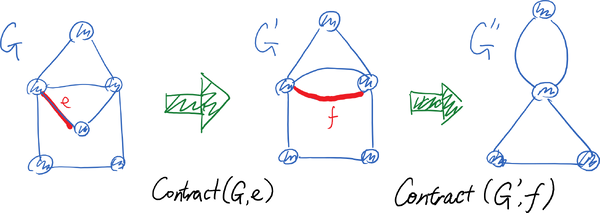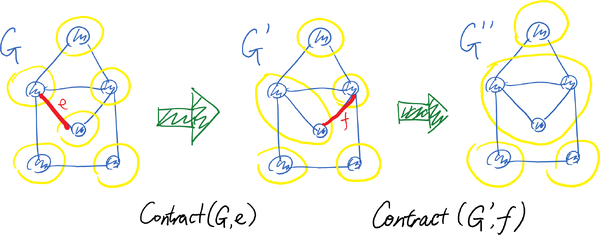概率论与数理统计 (Spring 2024)/Karger's min-cut algorithm: Difference between revisions
| Line 42: | Line 42: | ||
另一种看待收缩操作 <math>\mathsf{Contract}(G,e)</math> 的方式是将其解读为对两个顶点的等价类的合并。假设 <math>V={v_1,v_2,\ldots,v_n}</math> 是所有顶点的集合。我们从 <math>n</math> 个顶点等价类 <math>S_1,S_2,\ldots, S_n</math> 开始,其中每个等价类 <math>S_i={v_i}</math> 包含一个顶点。通过调用 <math>\mathsf{Contract}(G,e)</math>,其中 <math>e</math> 跨越了两个不同的等价类 <math>S_i</math> 和 <math>S_j</math>,其效果是将等价类 <math>S_i</math> 和 <math>S_j</math> 合并。收缩后的多重图中的边就是跨越不同顶点等价类之间的边。 | 另一种看待收缩操作 <math>\mathsf{Contract}(G,e)</math> 的方式是将其解读为对两个顶点的等价类的合并。假设 <math>V={v_1,v_2,\ldots,v_n}</math> 是所有顶点的集合。我们从 <math>n</math> 个顶点等价类 <math>S_1,S_2,\ldots, S_n</math> 开始,其中每个等价类 <math>S_i={v_i}</math> 包含一个顶点。通过调用 <math>\mathsf{Contract}(G,e)</math>,其中 <math>e</math> 跨越了两个不同的等价类 <math>S_i</math> 和 <math>S_j</math>,其效果是将等价类 <math>S_i</math> 和 <math>S_j</math> 合并。收缩后的多重图中的边就是跨越不同顶点等价类之间的边。 | ||
这一视角的效果如图所示: | |||
[[Image:Contract_class.png|600px|center]] | [[Image:Contract_class.png|600px|center]] | ||
Revision as of 12:05, 19 March 2024
令 [math]\displaystyle{ G(V, E) }[/math] 是一个无向图。我们称边集 [math]\displaystyle{ C\subseteq E }[/math] 是图 [math]\displaystyle{ G }[/math] 的一个割,如果图 [math]\displaystyle{ G }[/math] 在删除所有 [math]\displaystyle{ C }[/math] 中的边后变得不连通。
最小割问题, 也称为全局最小割问题, 定义如下。
全局最小割问题 - 输入:无向图 [math]\displaystyle{ G(V,E) }[/math];
- 输出:图 [math]\displaystyle{ G }[/math] 中具有最小 [math]\displaystyle{ |C| }[/math] 的割 [math]\displaystyle{ C }[/math]。
等价地,该问题要求找到一个将 [math]\displaystyle{ V }[/math] 分成两个不相交非空子集 [math]\displaystyle{ S }[/math] 和 [math]\displaystyle{ T }[/math] 的划分,使得跨越 [math]\displaystyle{ S }[/math] 和 [math]\displaystyle{ T }[/math] 的边总数最小。
我们考虑如下更具一般性的情境:输入图 [math]\displaystyle{ G }[/math] 可以是多重图(multigraph),这意味着任意两个顶点 [math]\displaystyle{ u }[/math] 和 [math]\displaystyle{ v }[/math] 之间可能存在多条平行边(parallel edges)。多重图中的割的定义与之前相同,割 [math]\displaystyle{ C }[/math] 的大小则由 [math]\displaystyle{ C }[/math] 中所有边(包括平行边)的总数给出。等价地,可以将多重图视为带有整数边权重的图,割 [math]\displaystyle{ C }[/math] 的大小表示为 [math]\displaystyle{ C }[/math] 中所有边的总权重。
通过最大流-最小割定理,可以得到这个问题的一个经典的确定性算法。最大流算法可以找到一个最小的[math]\displaystyle{ s }[/math]-[math]\displaystyle{ t }[/math]割, 将由输入任意指定的一个源点 [math]\displaystyle{ s\in V }[/math] 和一个汇点 [math]\displaystyle{ t\in V }[/math] 分割开来。然后可以通过穷举来找到针对任意固定源点 [math]\displaystyle{ s }[/math] 和所有可能的汇点 [math]\displaystyle{ t\neq s }[/math] 的最小 [math]\displaystyle{ s }[/math]-[math]\displaystyle{ t }[/math] 割,从而求得全局最小割。
Karger算法
我们将描述一个简洁优美的随机化算法来解决最小割问题。该算法最初是由David Karger提出的。
给定一个多重图 [math]\displaystyle{ G(V,E) }[/math] 和一条边 [math]\displaystyle{ e\in E }[/math],我们定义如下的收缩操作 [math]\displaystyle{ \mathsf{Contract}(G,e) }[/math],将 [math]\displaystyle{ G }[/math] 更新为一个新的多重图。
收缩算子 [math]\displaystyle{ \mathsf{Contract}(G,e) }[/math] 设 [math]\displaystyle{ e=\{u,v\} }[/math]:
- 将顶点 [math]\displaystyle{ u,v }[/math] 替换为一个新顶点 [math]\displaystyle{ x }[/math];
- 对于图中任何一条连接 [math]\displaystyle{ u,v }[/math] 其中之一到 [math]\displaystyle{ u,v }[/math] 以外某顶点 [math]\displaystyle{ w\in V\setminus{u,v} }[/math] 的边(无论是否平行),用一条新边 [math]\displaystyle{ \{x,w\} }[/math] 替换它;
- 图中剩余的部分保持不变。
换言之,[math]\displaystyle{ \mathsf{Contract}(G,\{u,v\}) }[/math] 将两个顶点 [math]\displaystyle{ u }[/math] 和 [math]\displaystyle{ v }[/math] 合并成一个新顶点 [math]\displaystyle{ x }[/math],该新顶点邻接的边保留了原始图 [math]\displaystyle{ G }[/math] 中与 [math]\displaystyle{ u,v }[/math] 两顶点之一邻接的边(但不包括二者之间的平行边 [math]\displaystyle{ \{u,v\} }[/math])。现在我们应该能意识到为什么我们考虑多重图而不是简单图——因为即使我们从没有平行边的简单图开始,收缩操作也可能引入平行边。
收缩操作的效果如图所示:

Karger算法的想法很简单:在每一步中,随机选择当前多重图中的一条边,将其收缩;重复这一操作,直至图中只剩下两个顶点——这两个剩下的顶点之间的所有边的集合,必然是最初图(乃至每一步中的图)中的一个割。
收缩算法 (Karger 1993) - 输入: 多重图 [math]\displaystyle{ G(V,E) }[/math];
- while [math]\displaystyle{ |V|\gt 2 }[/math] do
- 从当前图中依均匀分布选择一条随机的边 [math]\displaystyle{ e\in E }[/math];
- [math]\displaystyle{ G=\mathsf{Contract}(G,e) }[/math];
- return [math]\displaystyle{ C=E }[/math] (即当前所剩的最后两个顶点之间所有的平行边);
另一种看待收缩操作 [math]\displaystyle{ \mathsf{Contract}(G,e) }[/math] 的方式是将其解读为对两个顶点的等价类的合并。假设 [math]\displaystyle{ V={v_1,v_2,\ldots,v_n} }[/math] 是所有顶点的集合。我们从 [math]\displaystyle{ n }[/math] 个顶点等价类 [math]\displaystyle{ S_1,S_2,\ldots, S_n }[/math] 开始,其中每个等价类 [math]\displaystyle{ S_i={v_i} }[/math] 包含一个顶点。通过调用 [math]\displaystyle{ \mathsf{Contract}(G,e) }[/math],其中 [math]\displaystyle{ e }[/math] 跨越了两个不同的等价类 [math]\displaystyle{ S_i }[/math] 和 [math]\displaystyle{ S_j }[/math],其效果是将等价类 [math]\displaystyle{ S_i }[/math] 和 [math]\displaystyle{ S_j }[/math] 合并。收缩后的多重图中的边就是跨越不同顶点等价类之间的边。 这一视角的效果如图所示:

Analysis of Karger's Algorithm
We now analyze the above algorithm. Since the algorithm is randomized, its output cut is random even when the input is fixed, so the output may not always be correct. We want to give a theoretical guarantee of the chance that the algorithm returns a correct answer on an arbitrary input.
More precisely, on an arbitrarily fixed input multi-graph [math]\displaystyle{ G }[/math], we want to answer the following question rigorously:
- [math]\displaystyle{ p_{\text{correct}}=\Pr[\,\text{a minimum cut is returned by }RandomContract\,]\ge ? }[/math]
To answer this question, we prove a stronger statement: for arbitrarily fixed input multi-graph [math]\displaystyle{ G }[/math] and a particular minimum cut [math]\displaystyle{ C }[/math] in [math]\displaystyle{ G }[/math],
- [math]\displaystyle{ p_{C}=\Pr[\,C\mbox{ is returned by }RandomContract\,]\ge ? }[/math]
Obviously this will imply the previous lower bound for [math]\displaystyle{ p_{\text{correct}} }[/math] because the event in [math]\displaystyle{ p_{C} }[/math] implies the event in [math]\displaystyle{ p_{\text{correct}} }[/math].
- In above argument we use the simple law in probability that [math]\displaystyle{ \Pr(A)\le \Pr(B) }[/math] if [math]\displaystyle{ A\subseteq B }[/math], i.e. event [math]\displaystyle{ A }[/math] implies event [math]\displaystyle{ B }[/math].
We introduce the following notations:
- Let [math]\displaystyle{ e_1,e_2,\ldots,e_{n-2} }[/math] denote the sequence of random edges chosen to contract in a running of RandomContract algorithm.
- Let [math]\displaystyle{ G_1=G }[/math] denote the original input multi-graph. And for [math]\displaystyle{ i=1,2,\ldots,n-2 }[/math], let [math]\displaystyle{ G_{i+1}=Contract(G_{i},e_i) }[/math] be the multigraph after [math]\displaystyle{ i }[/math]th contraction.
Obviously [math]\displaystyle{ e_1,e_2,\ldots,e_{n-2} }[/math] are random, and they are the only random choices used in the algorithm: meaning that they along with the input [math]\displaystyle{ G }[/math], uniquely determine the sequence of multi-graphs [math]\displaystyle{ G_1,G_2,\ldots,G_{n-2} }[/math] in every iteration as well as the final output.
We now compute the probability [math]\displaystyle{ p_C }[/math] by decompose it into more elementary events involving [math]\displaystyle{ e_1,e_2,\ldots,e_{n-2} }[/math]. This is due to the following proposition.
Proposition 1 - If [math]\displaystyle{ C }[/math] is a minimum cut in a multi-graph [math]\displaystyle{ G }[/math] and [math]\displaystyle{ e\not\in C }[/math], then [math]\displaystyle{ C }[/math] is still a minimum cut in the contracted graph [math]\displaystyle{ G'=contract(G,e) }[/math].
Proof. We first observe that contraction will never create new cuts: every cut in the contracted graph [math]\displaystyle{ G' }[/math] must also be a cut in the original graph [math]\displaystyle{ G }[/math].
We then observe that a cut [math]\displaystyle{ C }[/math] in [math]\displaystyle{ G }[/math] "survives" in the contracted graph [math]\displaystyle{ G' }[/math] if and only if the contracted edge [math]\displaystyle{ e\not\in C }[/math].
Both observations are easy to verify by the definition of contraction operator (in particular, easier to verify if we take the vertex class interpretation).
- [math]\displaystyle{ \square }[/math]
Recall that [math]\displaystyle{ e_1,e_2,\ldots,e_{n-2} }[/math] denote the sequence of random edges chosen to contract in a running of RandomContract algorithm.
By Proposition 1, the event [math]\displaystyle{ \mbox{``}C\mbox{ is returned by }RandomContract\mbox{''}\, }[/math] is equivalent to the event [math]\displaystyle{ \mbox{``}e_i\not\in C\mbox{ for all }i=1,2,\ldots,n-2\mbox{''} }[/math]. Therefore:
- [math]\displaystyle{ \begin{align} p_C &= \Pr[\,C\mbox{ is returned by }{RandomContract}\,]\\ &= \Pr[\,e_i\not\in C\mbox{ for all }i=1,2,\ldots,n-2\,]\\ &= \prod_{i=1}^{n-2}\Pr[e_i\not\in C\mid \forall j\lt i, e_j\not\in C]. \end{align} }[/math]
The last equation is due to the chain rule.
Now our task is to give lower bound to each [math]\displaystyle{ p_i=\Pr[e_i\not\in C\mid \forall j\lt i, e_j\not\in C] }[/math]. The condition [math]\displaystyle{ \mbox{``}\forall j\lt i, e_j\not\in C\mbox{''} }[/math] means the min-cut [math]\displaystyle{ C }[/math] survives all first [math]\displaystyle{ i-1 }[/math] contractions [math]\displaystyle{ e_1,e_2,\ldots,e_{i-1} }[/math], which due to Proposition 1 means that [math]\displaystyle{ C }[/math] is also a min-cut in the multi-graph [math]\displaystyle{ G_i }[/math] obtained from applying the first [math]\displaystyle{ (i-1) }[/math] contractions.
Then the conditional probability [math]\displaystyle{ p_i=\Pr[e_i\not\in C\mid \forall j\lt i, e_j\not\in C] }[/math] is the probability that no edge in [math]\displaystyle{ C }[/math] is hit when a uniform random edge in the current multi-graph is chosen assuming that [math]\displaystyle{ C }[/math] is a minimum cut in the current multi-graph. Intuitively this probability should be bounded from below, because as a min-cut [math]\displaystyle{ C }[/math] should be sparse among all edges. This intuition is justified by the following proposition.
Proposition 2 - If [math]\displaystyle{ C }[/math] is a min-cut in a multi-graph [math]\displaystyle{ G(V,E) }[/math], then [math]\displaystyle{ |E|\ge \frac{|V||C|}{2} }[/math].
Proof. - It must hold that the degree of each vertex [math]\displaystyle{ v\in V }[/math] is at least [math]\displaystyle{ |C| }[/math], or otherwise the set of edges incident to [math]\displaystyle{ v }[/math] forms a cut of size smaller than [math]\displaystyle{ |C| }[/math] which separates [math]\displaystyle{ \{v\} }[/math] from the rest of the graph, contradicting that [math]\displaystyle{ C }[/math] is a min-cut. And the bound [math]\displaystyle{ |E|\ge \frac{|V||C|}{2} }[/math] follows directly from applying the handshaking lemma to the fact that every vertex in [math]\displaystyle{ G }[/math] has degree at least [math]\displaystyle{ |C| }[/math].
- [math]\displaystyle{ \square }[/math]
Let [math]\displaystyle{ V_i }[/math] and [math]\displaystyle{ E_i }[/math] denote the vertex set and edge set of the multi-graph [math]\displaystyle{ G_i }[/math] respectively, and recall that [math]\displaystyle{ G_i }[/math] is the multi-graph obtained from applying first [math]\displaystyle{ (i-1) }[/math] contractions. Obviously [math]\displaystyle{ |V_{i}|=n-i+1 }[/math]. And due to Proposition 2, [math]\displaystyle{ |E_i|\ge \frac{|V_i||C|}{2} }[/math] if [math]\displaystyle{ C }[/math] is still a min-cut in [math]\displaystyle{ G_i }[/math].
The probability [math]\displaystyle{ p_i=\Pr[e_i\not\in C\mid \forall j\lt i, e_j\not\in C] }[/math] can be computed as
- [math]\displaystyle{ \begin{align} p_i &=1-\frac{|C|}{|E_i|}\\ &\ge1-\frac{2}{|V_i|}\\ &=1-\frac{2}{n-i+1} \end{align}, }[/math]
where the inequality is due to Proposition 2.
We now can put everything together. We arbitrarily fix the input multi-graph [math]\displaystyle{ G }[/math] and any particular minimum cut [math]\displaystyle{ C }[/math] in [math]\displaystyle{ G }[/math].
- [math]\displaystyle{ \begin{align} p_{\text{correct}} &=\Pr[\,\text{a minimum cut is returned by }RandomContract\,]\\ &\ge \Pr[\,C\mbox{ is returned by }{RandomContract}\,]\\ &= \Pr[\,e_i\not\in C\mbox{ for all }i=1,2,\ldots,n-2\,]\\ &= \prod_{i=1}^{n-2}\Pr[e_i\not\in C\mid \forall j\lt i, e_j\not\in C]\\ &\ge \prod_{i=1}^{n-2}\left(1-\frac{2}{n-i+1}\right)\\ &= \prod_{k=3}^{n}\frac{k-2}{k}\\ &= \frac{2}{n(n-1)}. \end{align} }[/math]
This gives us the following theorem.
Theorem - For any multigraph with [math]\displaystyle{ n }[/math] vertices, the RandomContract algorithm returns a minimum cut with probability at least [math]\displaystyle{ \frac{2}{n(n-1)} }[/math].
At first glance this seems to be a quite slim chance of success. However, notice that there may be exponential many cuts in a graph (because potentially every nonempty subset [math]\displaystyle{ S\subset V }[/math] corresponds to a cut [math]\displaystyle{ C=E(S,\overline{S}) }[/math]), and Karger's algorithm effectively reduce this exponential-sized space to quadratic-sized, an exponential improvement!
We can run RandomContract independently for [math]\displaystyle{ t=\left\lceil\frac{n(n-1)\ln n}{2}\right\rceil }[/math] times and return the smallest cut ever returned. The probability that a minimum cut is found is at least:
- [math]\displaystyle{ \begin{align} &\quad 1-\Pr[\,\mbox{all }t\mbox{ independent runnings of } RandomContract\mbox{ fails to find a min-cut}\,] \\ &= 1-\Pr[\,\mbox{a single running of }{RandomContract}\mbox{ fails}\,]^{t} \\ &\ge 1- \left(1-\frac{2}{n(n-1)}\right)^{\frac{n(n-1)\ln n}{2}} \\ &\ge 1-\frac{1}{n}. \end{align} }[/math]
A Consequence of the Probabilistic Method
The analysis of Karger's algorithm implies the following combinatorial proposition for the number of distinct minimum cuts in a graph.
Corollary - For any graph [math]\displaystyle{ G(V,E) }[/math] of [math]\displaystyle{ n }[/math] vertices, the number of distinct minimum cuts in [math]\displaystyle{ G }[/math] is at most [math]\displaystyle{ \frac{n(n-1)}{2} }[/math].
Proof. Let [math]\displaystyle{ \mathcal{C} }[/math] denote the set of all minimum cuts in [math]\displaystyle{ G }[/math]. For each min-cut [math]\displaystyle{ C\in\mathcal{C} }[/math], let [math]\displaystyle{ A_C }[/math] denote the event "[math]\displaystyle{ C }[/math] is returned by RandomContract", whose probability is given by
- [math]\displaystyle{ p_C=\Pr(A_C)\, }[/math].
Clearly we have:
- for any distinct [math]\displaystyle{ C,D\in\mathcal{C} }[/math], [math]\displaystyle{ A_C\, }[/math] and [math]\displaystyle{ A_{D}\, }[/math] are disjoint events; and
- the union [math]\displaystyle{ \bigcup_{C\in\mathcal{C}}A_C }[/math] is precisely the event "a minimum cut is returned by RandomContract", whose probability is given by
- [math]\displaystyle{ p_{\text{correct}}=\Pr[\,\text{a minimum cut is returned by } RandomContract\,] }[/math].
Due to the additivity of probability, it holds that
- [math]\displaystyle{ p_{\text{correct}}=\sum_{C\in\mathcal{C}}\Pr(A_C)=\sum_{C\in\mathcal{C}}p_C. }[/math]
By the analysis of Karger's algorithm, we know [math]\displaystyle{ p_C\ge\frac{2}{n(n-1)} }[/math]. And since [math]\displaystyle{ p_{\text{correct}} }[/math] is a well defined probability, due to the unitarity of probability, it must hold that [math]\displaystyle{ p_{\text{correct}}\le 1 }[/math]. Therefore,
- [math]\displaystyle{ 1\ge p_{\text{correct}}=\sum_{C\in\mathcal{C}}p_C\ge|\mathcal{C}|\frac{2}{n(n-1)} }[/math],
which means [math]\displaystyle{ |\mathcal{C}|\le\frac{n(n-1)}{2} }[/math].
- [math]\displaystyle{ \square }[/math]
Note that the statement of this theorem has no randomness at all, while the proof consists of a randomized procedure. This is an example of the probabilistic method.